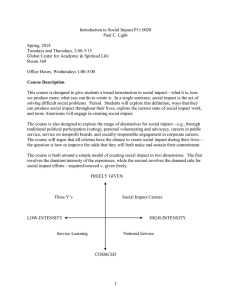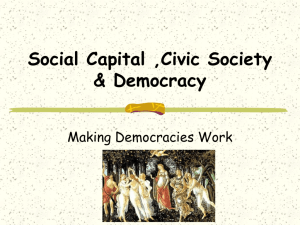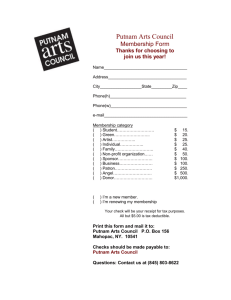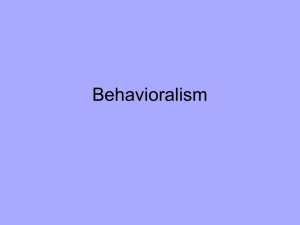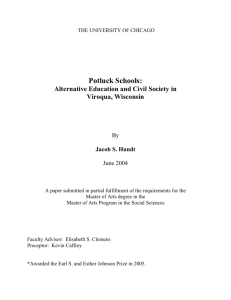UPADM-GP.102.001
advertisement
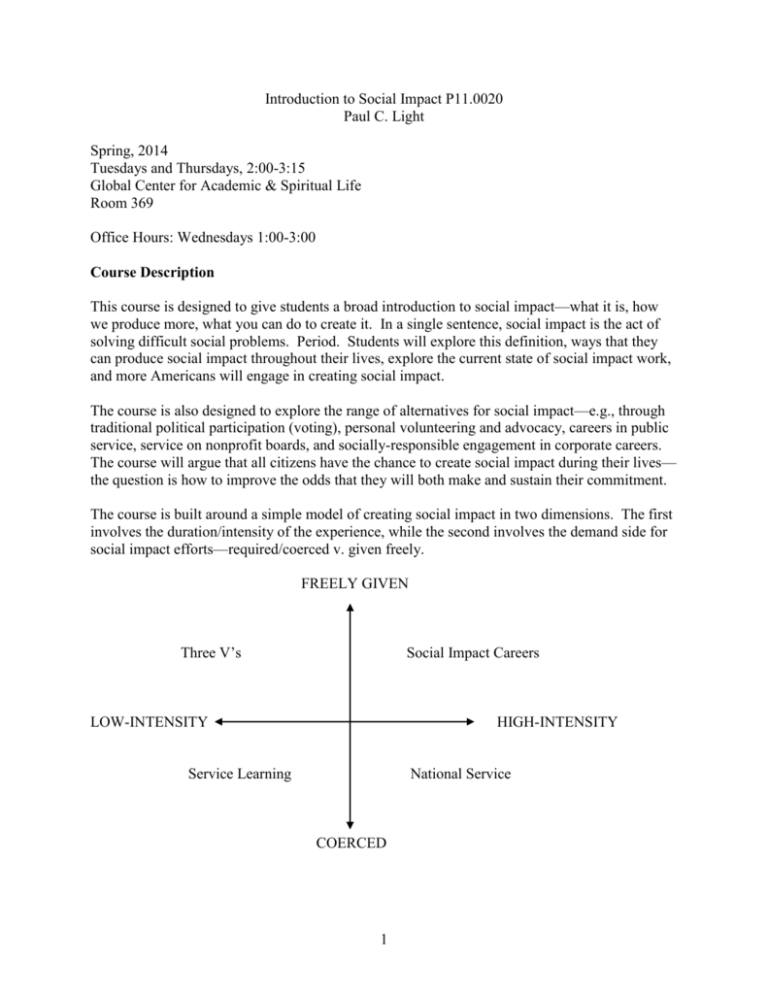
Introduction to Social Impact P11.0020 Paul C. Light Spring, 2014 Tuesdays and Thursdays, 2:00-3:15 Global Center for Academic & Spiritual Life Room 369 Office Hours: Wednesdays 1:00-3:00 Course Description This course is designed to give students a broad introduction to social impact—what it is, how we produce more, what you can do to create it. In a single sentence, social impact is the act of solving difficult social problems. Period. Students will explore this definition, ways that they can produce social impact throughout their lives, explore the current state of social impact work, and more Americans will engage in creating social impact. The course is also designed to explore the range of alternatives for social impact—e.g., through traditional political participation (voting), personal volunteering and advocacy, careers in public service, service on nonprofit boards, and socially-responsible engagement in corporate careers. The course will argue that all citizens have the chance to create social impact during their lives— the question is how to improve the odds that they will both make and sustain their commitment. The course is built around a simple model of creating social impact in two dimensions. The first involves the duration/intensity of the experience, while the second involves the demand side for social impact efforts—required/coerced v. given freely. FREELY GIVEN Three V’s Social Impact Careers LOW-INTENSITY HIGH-INTENSITY Service Learning National Service COERCED 1 Course Requirements Students are required to attend all classes and complete all assignments on time. The class will be built around discussion of the readings. Readings are to be completed before class. There will be a final examination, a research paper making a single recommendation for increasing the amount of public service, which will be due on the last day of class. Final grades will be based on the following formula. The research paper is to be 5,000 words or less with at least 10 peerreviewed academic research sources.1 20% class participation 50% research paper 30% final exam Readings There is just one required book for this class: Russell J. Dalton, The Good Citizen: How a Younger Generation is Reshaping American Politics All other readings are on NYU CLASSES or through links to the Internet 1 Peer reviewed sources can be found at ProQuest central: (1) go to home.nyu.edu, (2) click on the research tab, (3) click on databases A-Z, (4) type in ProQuest central, (5) select ProQuest central, (6) open the advanced search tab, (7) enter your term(s), click on the “peer reviewed” box under search options, and (8) sort your results from most recent to oldest. 2 COURSE SCHEDULE Week 1a. Introduction Week 1b. What did the Framers Think of Us? U.S. Constitution, find it online and bookmark it The Federalist, no. 10 (“The Mischiefs of Faction”), no. 51 (“Checks and Balances”), and no. 68 (“The Mode of Electing the President”), find it online and bookmark it Week 2a: What is Social Impact? Geoff Mulgan, “Measuring Social Value,” Stanford Social Innovation Review, 2010 Lisbeth B. Schorr, “Broader Evidence for Bigger Impact,” Stanford Social Innovation Review, 2013 Fay Twersky, Phil Buchanan, & Valerie Threlfall, “Listening to Those Who Matter Most, the Beneficiaries,” Stanford Social Innovation Review, 2013 Week 2b: How Do We Map It? W.K. Kellogg Foundation, Logic Model Development Guide, 2004, chapters 1-4 Week 3a: Why Do You Care About Social Impact Anyway? Francis B. M. de Waal, “The Antiquity of Empathy,” Science, 2012 C. Daniel Batson, Nadia Ahmad, and Jo-Ann Tsang, “Four Motives for Community Involvement,” Journal of Social Issues, 2002 Pew Research Center, Millennials: A Portrait of General Next, February 2010 Sara H. Konrath, et al. “Changes in Dispositional Empathy in American College Students Over Time: A Meta-Analysis,” Personality and Social Psychology Review, 2010 (Prepare a list of three findings of interest to you) Week 3b: What is Your Problem? Horst W. J. Rittel, and Melvin M. Webber, “Dilemmas in a General Theory of Planning,” Policy Sciences, 1973 Bill Shore, Darell Hammond, & Amy Celep, “When Good Is Not Good Enough,” Stanford Social Innovation Review, Fall 2013 3 Cynthia Gibson, Katya Smyth, Gail Nayowith, & Jonathan Zaff, “To Get to the Good, You Gotta Dance With the Wicked,” Stanford Social Innovation Review, blog post, September 19, 2013 Week 4a: What Can You Do? Dalton, The Good Citizen, chapters 1-5 Paul Light, “The Spiral of Sustainable Excellence,” in Paul Light, Sustaining Performance: The Case for Capacity Building and the Evidence to Prove It, 2004 Karen Xu, “Popular Science,” Harvard Magazine, January/February, 2014 Week 4b: What Are the Barriers to Impact? Thomas E. Mann & Norman J. Ornstein, “Finding the Common Good in an Era of Dysfunctional Governance,” Daedalus, 2013 Daniel Kaufmann, Aart Kraay and Massimo Mastruzzi, “The Worldwide Governance Indicators: Methodological and Analytical Issues,” September 2010 (After reading about the indicators and aggregating methodology, visit http://info.worldbank.org/governance/wgi/mc_countries.asp, and see how the indicators work by selecting countries, regions, and/or the world to examine the ratings Paul Theroux, “Africa’s Aid Mess,” Barron’s, November 30, 2013 Week 5a: What Does the Future Hold? Arnoud De Meyer, Christoph H. Loch and Michael T. Pich, “Managing Project Uncertainty: From Variation to Chaos,” MIT Sloan Management Review, 2002 Muhammad Amer, Tugrul U. Daim, Antonie Jetter, “A Review of Scenario Planning,” Futures, 2013 Week 5b: How Do You Find the Solution? Tim Brown, “Design Thinking,” Harvard Business Review, 2009 Andrew B. Hargadon and Yellowlees, “When Innovations Meet Institutions: Edison and the Design of the Electric Light,” Administrative Science Quarterly, 2001 Mary Bryna Sanger and Martin A. Levin, “Using Old Stuff in New Ways: Innovation as a Case of Evolutionary Tinkering,” Journal of Policy Analysis and Management, 1992 Week 6a. Have You Done the Reading? 4 Check-in test to determine type of final exam Week 6b: What is the Current Context? Robert D. Putnam, “Tuning In, Tuning Out: The Strange Disappearance of Social Capital in America,” PS: Political Science and Politics, December 1995 Robert D. Putnam, “Bowling Together,” American Prospect, February 11, 2002 Thomas H. Sander and Robert D. Putnam, “Still Bowling Alone? The Post-9/11 Split,” January 2010 Robert D. Putnam, “Crumbling American Dreams,” New York Times, August 3, 2013 John Miller, “Active, Balanced, and Happy: These Young Americans Are Not Bowling Alone,” 2011 THE FIRST QUADRANT OF IMPACT: FREELY GIVEN/LOW INTNSITY Week 7a: Why Not Watch TV? Pew Research Center, Civic Engagement in the Digital Age, 2013 Commission on Youth Voting and Civic Knowledge, All Together Now: Collaboration and Innovation for Youth Engagement, 2013 (Browse for tone and broad findings) Sebastián Valenzuela, “Unpacking the Use of Social Media for Protest Behavior: The Roles of Information, Opinion Expression, and Activism,” American Behavioral Scientist, 2013 Week 7b: Does Anyone Want Your Help? Theda Skocpol, Marshall Ganz, and Ziad Munson, “A Nation of Organizers: The Institutional Origins of Civic Volunteerism in the United States,” American Political Science Review, September 2000 Theda Skocpol, Rachel Cobb, and Casey Klofstad, “Disconnection and Reorganization: The Transformation of Civic Life in Late-Twentieth Century America,” Studies in American Political Development, Fall 2005 THE SECOND QUADRANT: REQUIRED/LOW INTENSITY Week 8a: Where Did You Learn How to Crack the World? Campaign for the Civic Mission of Schools Campaign for the Civic Mission of Schools, Guardians of Democracy: The Civic Mission of Schools, 2011, entire 5 John R. Rachal, “We’ll Never Turn Back: Adult Education and the Struggle for Citizenship in Mississippi’s Freedom Summer,” American Educational Research Journal, 1998 Week 8b: What Did You Learn? Christine I. Celio, Joseph Durlak, and Allison Dymnicki “A Meta-analysis of the Impact of Service-Learning on Students,” Journal of Experiential Education, 2011 Sara E. Helms, ”Involuntary Service: The Impact of Mandated Service in Public Schools,” Economics of Education Review, 2013 A CIRCLE IN THE CENTER: CORPORATE SOCIAL RESPONSIBILITY Week 9a: Can Corporations Behave? Margaret E. Ormiston, and Elaine M. Wong, “License to Ill: The Effects of Corporate Social Responsibility and CEO Moral Identity on Corporate Social Irresponsibility,” Personnel Psychology, 2013 Herman Aguinis and Ante Glavas, “Review and Research Agenda: What We Know and Don’t Know About Corporate Social Responsibility,” Academy of Management, 2012 READ AS CASE STUDY: Ataur Rahman Belal, and Stuart Cooper, “The Absence of Corporate Social Responsibility Reporting in Bangladesh,” Critical Perspectives on Accounting, 2011 Stephanie Clifford, and Steven Greenhouse, “Fast and Flawed Inspections of Factories Abroad,” New York Times, September 1, 2013 Jim Yardley, “Clothing Brands Sidestep Blame for Safety Lapses,” New York Times, December 30, 2013 Week 9b: Can Corporations Control Themselves? Gael M. Mcdonald, “An Anthology of Codes of Ethics,” European Business Review, 2009 John C. Lere, and Bruce R. Gaumnitz, “Changing Behavior by Improving Codes of Ethics,” American Journal of Business, 2007 Eric D. Raile, “Building Ethical Capital: Perceptions of Ethical Climate in the Public Sector,” Public Administration Review, 2013 6 THE THIRD QUADRANT OF IMPACT: FREELY GIVEN/HIGH INTENSITY Week 10a: Why Do You Work? Gloria Larson, and Mike Metzger, “Why Everyone is Wrong about Working with Millennials: Millennials Aren’t as Lazy and Entitled as They’re Made Out to Be,” Fast Company, December, 2013 Donna Lind Infeld, and William C. Adams, “MPA and MPP Students: Twins, Siblings, or Distant Cousins?” Journal of Public Affairs Education, 2011 Week 10b: What Are Your Options? Paul C. Light, Driving Social Change: How to Solve the World’s Toughest Problems, chapters 1-2 Christian Seelos, and Johanna Mair, “Innovation is Not the Holy Grail,” Stanford Social Innovation Review, Fall 2012 Week 11a: How Do You Work? Pino Audia and Christopher Rider, “A Garage and an Idea: What More Does an Entrepreneur Need?” California Management Review, 2005 Jasjit Singh, and Lee Fleming, “Lone Inventors as Sources of Breakthroughs: Myth or Reality?” Management Science, 2010 Elizabeth Watson, “Who or What Creates? A Conceptual Framework for Social Creativity,” Human Resource Development Review, 2007 Week 11b: How is the Paper Going? Bring draft of your problem statement with at least 10 sources already identified Week 12a: Where Can You Make a Difference? Paul C. Light, Education for Public Service, Memo prepared for the Volcker Alliance for Effective Governance, Salzburg Seminar, 2013 Paul C. Light, “A Government Ill Executed: The Depletion of the Federal Service,” Public Administration Review, 2008 Week 12b: Why Not Just Run? 7 Cherie D. Maestas, Sarah Fulton, Sandy L. Maisel, and Walter J. Stone, “When to Risk It? Institutions, Ambitions, and the Decision to Run for the U.S. House,” American Political Science Review; May 2006 THE FOURTH QUADRANT OF IMPACT: REQUIRED/HIGH INTENSITY Week 13a: What about the All-Voluntary Force? Congressional Budget Office, “The All-Volunteer Military: Issues and Performance,” 2007 Week 13b: What about National Service? Carol Armistead Grigsby, “Binding the Nation: National Service in America,” Parameters, Winter 2008-09 David A. Reingold, and Leslie Lenkowsky, “The Future of National Service,” Public Administration Review, December, 2010 THE END Week 14a: Will Anything You Do Really Work? James Dewar, Assumption Based Planning: A Planning Tool for Very Uncertain Times, chapters 1-6 Week 14b: Will It Last? Paul C. Light, “From Endeavor to Achievement and Back Again: Government’s Greatest Hits in Peril,” in Steven Conn, ed., To Promote the General Welfare: The Case for Big Government, 2012 8
